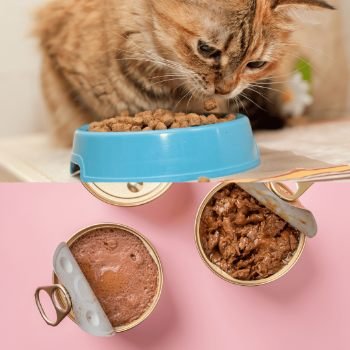Wet vs. Dry Cat Food: Differences & Which is Better?

Cat parents often have to consider a lot of things before selecting the right food for their feline buddy. Regardless of the countless flavors and variations, a key factor while making food choice is whether to feed dry or wet food.
Before we get into the nitty-gritty, it is important to highlight that both of these options are perfectly alright for cats, as long as the food is balanced and complete. Sometimes, vets may advise dry or wet food for cats based on their specific conditions.

Wet Cat Food
Wet food comes in cans or pouches and has a higher moisture content, around 65%. Most varieties contain chunks of food in gravy or moist form. The liquid content in the food gives it an appetizing aroma and a delicious taste that cats love.
The high moisture content makes wet food susceptible to going bad because it can act as a breeding ground for bacteria. Hence, it is better to not leave it out for more than 30 minutes in the summer and 60 minutes in the winter.
The leftovers must be stored in a refrigerator to prevent bacterial growth and keep the food fresh. Many cat parents explain that their cats don’t eat wet food leftovers, so it is better to buy pouches or cans of the right size. Another disadvantage of feeding wet food is its higher cost. Moreover, meals can be messy, and you have to clean not only your cat but also the feeding area.
An added benefit of wet food is that it is easier to chew for older cats. Moreover, cats that don’t drink much water can fulfill their daily water intake by eating wet food.

Dry Cat Food
Dry cat food (kibble) comes in bags of different sizes, and it is preferred by many cat owners due to its ease of use. Unlike wet food, it doesn’t go bad too quickly and doesn’t require refrigeration after opening. It can be stored at room temperature in airtight containers or Ziploc bags.
Dry food contains around 10% moisture, but it has a high carbohydrate content. A higher percentage of carbohydrates give dry food its shape and texture. The dry nature of kibble makes it an excellent choice for leaving it out all day for your cat to eat while you are away.
The lower water content in dry food means that it has a higher nutrient concentration. Cats can get everything they need while eating less. Dry food also helps reduce tartar on a cat’s teeth, aiding in better dental health.
Cats eating only dry food need to drink more water to stay hydrated. This isn’t much of an issue if you provide your cat with fresh and clean water all the time.
Another concern is the higher percentage of carbohydrates in dry food. Cats are obligate carnivores; feeding them too many carbohydrates can lead to health issues. However, most vets agree that a cat’s lifestyle, health, and quality of food play an important role in switching to wet food.

Is Dry or Wet Food Better for Cats?
As already explained, both foods are okay as long as they are complete. It is your cat who will ultimately decide whether he likes wet food or dry food.
Cats can stick to one food type for long but they love to try new things. They have a natural instinct to try new things and may get bored eating the same food every day. They are more like humans in this domain and want a variety of foods. This can be achieved by mixing wet and dry food or feeding them separately, which provides the change they seek.











